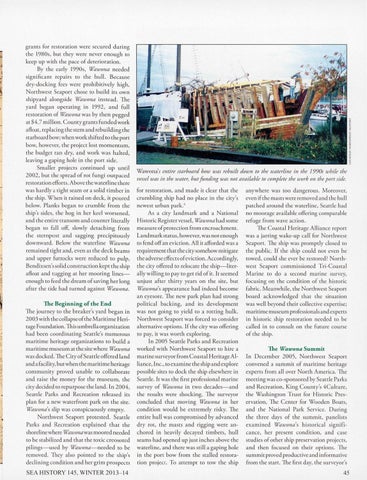.j
~
'
r• j
grams for restoration were secured during the 1980s, but they were never enough to keep up w ith the pace of deteri oration. By the early 1990s, Wawona needed significant repairs to the hull. Because dry-docking fees were prohibitively high, Nort hwest Seaport chose to build its own shipyard alongside Wawona instead. The yard began operating in 1992, and full restoration of Wawona was by then pegged at $4.7 million. County grams funded work afloat, replacing the stem a nd rebui !ding the starboard bow; when work shifted to the port bow, however, the project lost momentum, the budget ra n dry, and work was h alted , leaving a gaping hole in the port side. Smaller projects continued up until 2002, but the spread of rot fun gi o utpaced restoration efforts. Above the waterline there was h ardly a tight seam or a solid timber in the ship. When it rained on deck, it po ured below. Planks began to crumble from the ship's sides, the hog in her keel worsened, and the entire transom and counter literally began to fa ll off, slowly detaching from the sternpost and sagging precipitously downward. Below the waterline Wawona remained tight and, even as the deck beams and upper futtocks were reduced to pulp, Bendi xsen'ssolid construction kept the ship a fl oat and rugging at her mooring linesenough to feed the dream of saving her long after the tide had turned against Wawona .
The Beginning of the End
"::~...
The journey to the breaker's ya rd began in 2003 with the collapse of the M aritime Heritage Foundation. This umbrella organization had been coordinating Seattle's nu mero us maritime heritage organizations to build a ma ritime museum at the site where Wawona was docked. The C ity of Seattle offered land and a facility, but when the maritime heritage community proved unable to collaborate a nd raise the money for the museum, the city decided to repurpose the land. In 2004, Seattle Parks and Recreation released its plan fo r a new waterfront park on the site. Wawona's slip was conspicuously empty. Northwest Seaport protested . Seattle Parks and Recreation explained that the shoreline where Wawonawas moored n eeded to be stabilized and that the toxic creosoted pilings-used by Wawona-needed to be removed. They also pointed to the ship's declining condition and her grim prospects
SEA HISTORY 145, WINTER 2013- 14
Wawo na's entire starboard bow was rebuilt down to the waterline in the 1990s while the vessel was in the water, but funding was not available to complete the work on the port side. for restoration, and made it clear that the crumbling ship had no place in the city's newest urban park. 4 As a city landmark a nd a Nat ional Historic Register vessel, Wawona had so me measure of protection from encroac hment. Landmark status, however, was not enough to fend off an eviction. All it afforded was a requirement that the city somehow mitigate the adverse effects of eviction . Accordingly, the city offered to relocate the ship-literally willing to pay to get rid of it. It seemed unjust after thirty years on the site, but Wawona's appearance had indeed become an eyesore. The new park plan h ad strong political backin g, a nd its developm ent was not going to yield to a rotting hulk. Northwest Seaport was forced to consider alternative options. If the city was offering to pay, it was worth exploring. In 2005 Seattle Parks and Recreation worked with Northwest Seaport to hire a m arine surveyor from Coastal H eritage Alliance, Inc., to examine the ship and explore possible sites to dock the ship elsewhere in Seattle. It was the first professional m arine survey of Wawona in two decades-and the results were shocking. The surveyor concluded that moving Wawona in her condition would be extremely risky. The entire hull was compromised by advanced d ry rot, the m as ts and rigging were anchored in heavily decayed timbers, hull seams had opened up just inches above the wate rline, and there was still a gaping hole in the port bow from the stalled restoration project. To attempt to tow the ship
anywhere was too dangerous. Moreover, even if the masts were removed and the hull patched aro und the waterline, Seattle had no moorage available offering comparable refuge from wave action . The Coastal H eritage Alliance report was a jarring wake- up call for No rthwest Seaport. The ship was promptly closed to the public. If the sh ip could not even be towed , could she ever be restored? Northwest Seaport com miss ioned Tri-Coastal Marine to do a second marine survey, focusing on the condition of the h istoric fabric. Meanwhile, the Northwest Seaport board acknowledged that the situation was well beyond their collective expertise; m aritime museum professionals and experts in historic ship restoration needed to be called in to consult on the future course of the ship.
The Wawona Summit In December 2005, Northwest Seaport convened a summit of maritime heritage experts from all over North America. The meeting was co-sponsored by Seattle Parks and Recreation, King County's 4Culrure, the Washington Trust for Historic Preservation, The Center for Wooden Boats, a nd the National Park Service. During the three days of the summit, panelists exa mined Wawona's historical significance, her present condi tion, and case studies of other ship preservation projects, and then focused on their options. The summit proved productive and in formative from the start. 1l1e first day, the surveyor's
45
